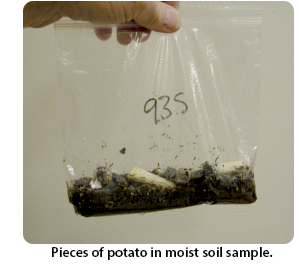Rinse infected tissue in cold tap water.
Examine some of the tissue with a light microscope for oospores. Whether you see oospores or not, use the coverslip to slide the tissue onto water agar. Also, plate some of the tissue on a selective medium (see Part 1: Media for Pythium Culture).
Incubate the plates for 24 hours. Most species of Pythium grow rapidly on water agar while anything else in the sample grows relatively slowly or not at all. Growth on selective media is usually slower than on water agar or agar lacking antibiotics.
Transfer hyphae to a new plate of water agar.
Incubate the plates for 24 hours.
Using a light microscope, examine the hyphae.
Transfer coenocytic hyphae to a new plate of agar. Do not throw away any plates with growth until you are certain you successfully transferred the organism and it is definitely growing on the new plate.
Isolating from Soil by Baiting
Wet the soil well enough that it glistens in the light but not so wet that it puddles. That is called a saturated paste (Richards, L. A. and Staff, U. S. S. L. 1954. Diagnosis and improvement of saline and alkali soils. U. S. Department of Agriculture handbook 60:8-9). Do this in a plastic bag and insert some slices of potato from a surface disinfested, peeled tuber. It is suggested that the slices be thin enough and of a size to be able to later place them on agar in a Petri plate of agar and close the lid (because that is the next step).

Incubate the baited soil for 24 hours at room temperature (~20-25°C)
Remove the pieces of potato and rinse off the soil in cold running tap water.
Place the slices on water agar or one of the selective media (see Part 1: Media for Pythium Culture).
Incubate the plates about 24 hours (No more than 48 hr. Usually if a lot of bacteria grow from the slice, Pythium will not be recovered regardless of the incubation time.)
Transfer hyphae to a new plate of water agar.
Incubate the plates for 24 hours. Most species of Pythium grow rapidly on water agar but sometimes they grow slowly while anything else in the sample grows very slowly or not at all.
Using a light microscope, examine the hyphae.
Transfer coenocytic hyphae to a new plate of agar. Do not throw away the original plate until you are certain you successfully transferred the organism and it is definitely growing on the new plate.

